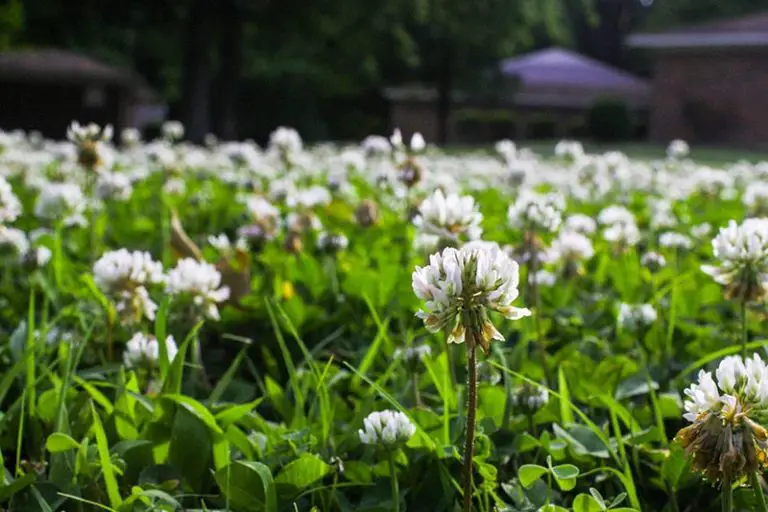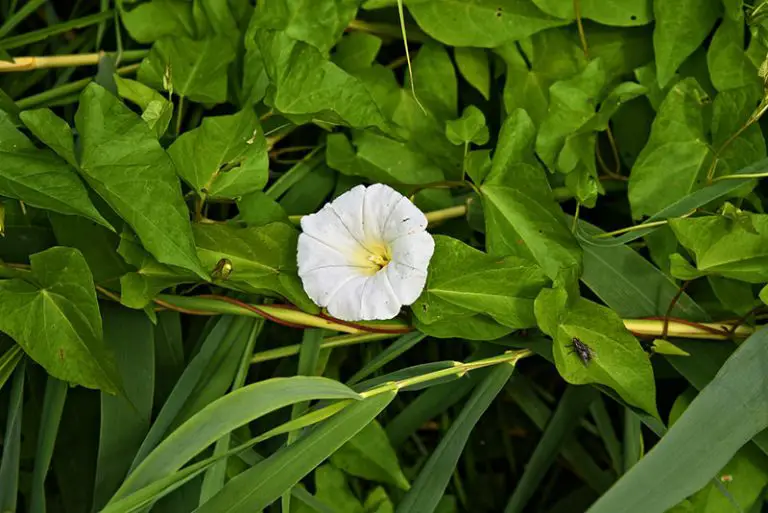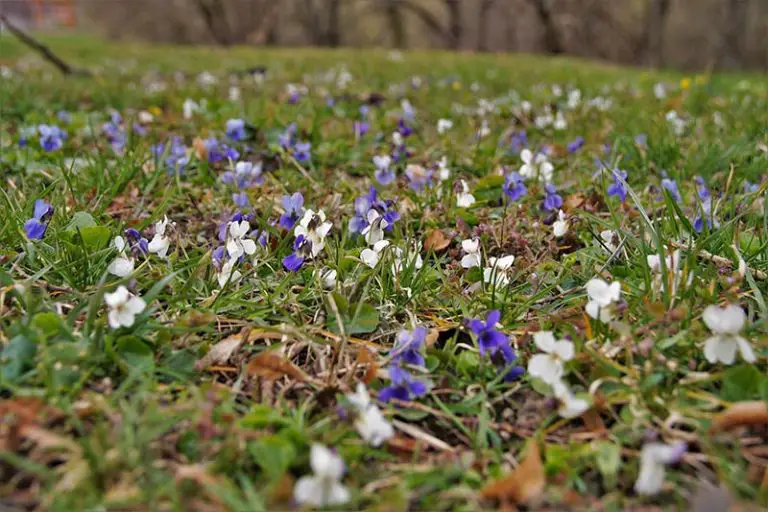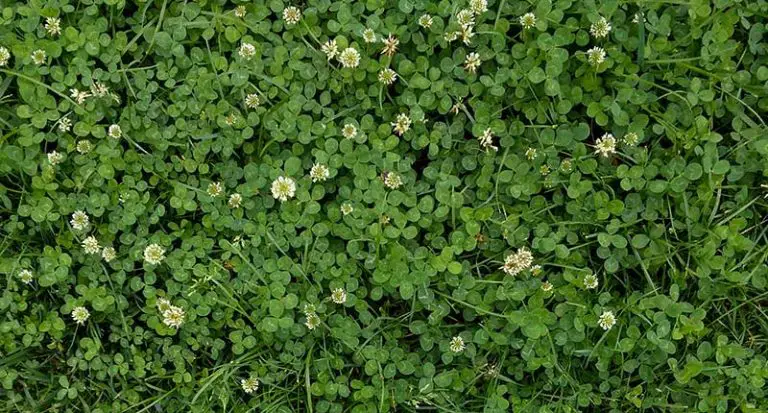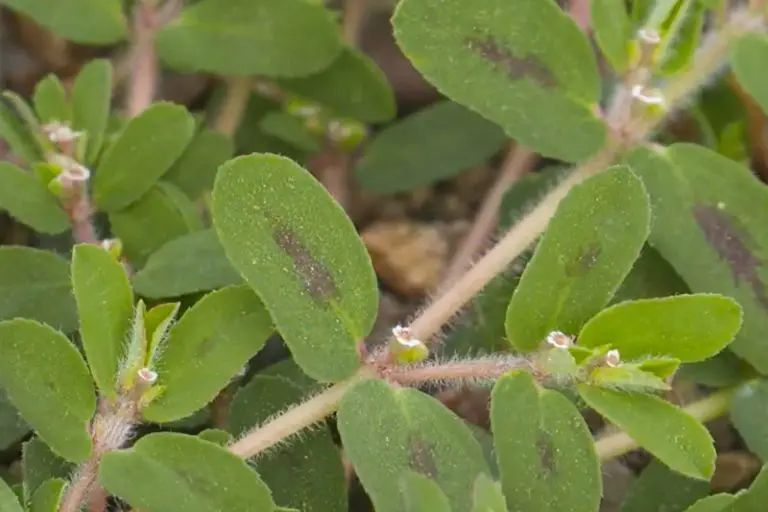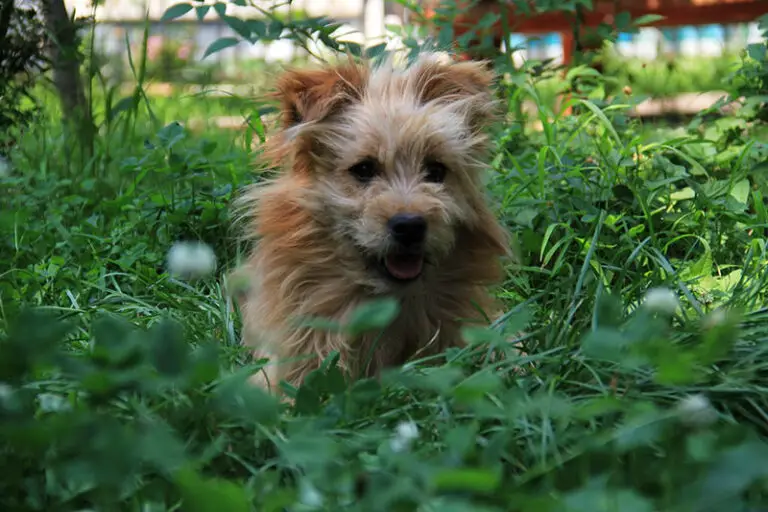How to Get Rid of Nutsedge
Nutsedge, or nut grass, is one of the most common and most difficult-to-remove types of weed you can have in your yard. It looks very similar to grass, however, it will outgrow most turfgrasses, leaving you with an unsightly garden or uneven lawn. It has an extensive root system, and is able to spread through soil quickly using rhizomes, seeds, and nutlets.
The only natural method to get rid of nutsedge is to remove it by hand, and this method is only effective on smaller-scale immature nutsedge infestations. In most cases, it will be necessary to use a chemical nutsedge killer to get rid of the nutsedge completely.
Read on to learn how to get rid of nutsedge from your lawn naturally and how to kill nutsedge with nutsedge killer. This guide also includes information on nutsedge identification and nutsedge control and prevention.
What is Nutsedge?
Nutsedge, also known as nut grass, is an invasive perennial weed. It prefers low-quality, moist soil, although it is also able to thrive in dry soil. It is a weed that looks like grass, but it grows noticeably faster than the rest of your lawn during the hotter months. In the spring and summer, you’ll likely see nut grass outgrowing the rest of the grass in a matter of days after mowing the lawn.
Despite its grassy appearance, nutsedge is classified as a sedge rather than a grass. While sedges look like grass, and spread through rhizomes and seeds like grass, they’re distinguished by their ability to also spread through nutlets. In essence, nutlets are round underground roots that, under the right conditions, spread quickly through soil by producing new stalks. These nutlets are what make nutsedge control so challenging compared to the control of other types of weeds or invasive plants.
Where Does Nutsedge Typically Grow?
Sedges like nutsedge typically grow and spread most voraciously in moist, compacted, poor-quality dirt.
Because of this, nutsedge will often take over yards that have drainage issues and/or overly compacted soil. Excessive watering or rainfall will also exacerbate these ideal conditions for nutsedge to grow in your lawn. With that said, nutsedge will still be able to grow in dry areas with sufficient drainage, provided there is little competition from other grass or plants.
What Does Nutsedge Look Like?
Taking a quick scan across your lawn, nutsedge will look very similar to the rest of the surrounding turfgrass. However, when the nutsedge plants mature, they take on a slightly different shade of green to the surrounding grass and often outgrow it in height.
General Nutsedge Identification
We have gone through the identifying features of nutsedge in more detail below.
Nutsedge Leaves and Stem – Nutsedge has a triangular-shaped stalk with yellow or green leaves. Each nutsedge plant has three leaves that grow from the plant’s base. The leaves tend to curve over, bending back towards the ground. Nutsedge typically grows faster than regular turfgrasses, meaning it will appear tall in your lawn compared to the rest of the grass. It will give the lawn an overall uneven appearance.
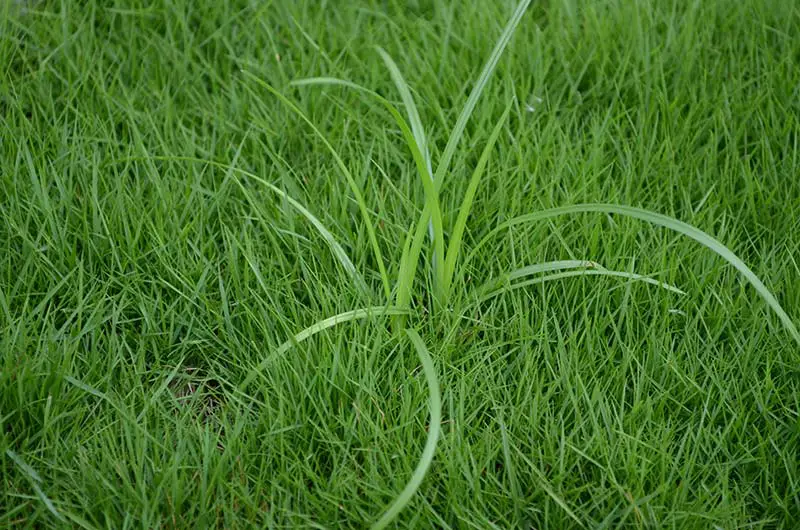
Nutsedge Flowers – If the nutsedge is left unmowed, it will form an unusual spikey flower at the top of the plant. The nutsedge flowers produce seeds. As the names suggest, yellow nutsedge produces a yellow flower, while purple nutsedge produces a purple flower.
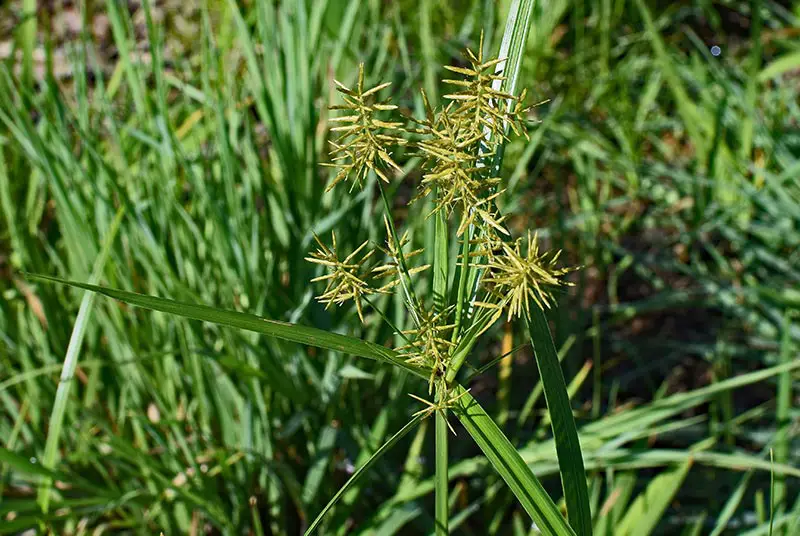
Nutsedge Roots – Nutsedge has a complex root system made up of fibrous rhizomes, roots, and tubers. Compared to grass, these roots are relatively thick, measuring up to 1/16” wide. The tubers sit at the end of some of the nutsedge plant’s roots, appearing as small bulbs. The rhizomes are the longer roots that extend further out from the plant.
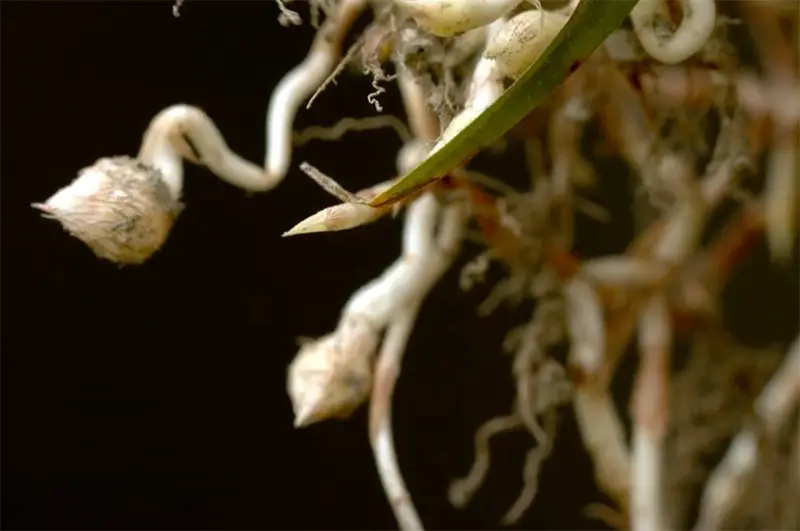
Yellow Nutsedge vs Purple Nutsedge
There are two main varieties of nutsedge plants; yellow nutsedge and purple nutsedge. Purple nutsedge is less tolerant of the cold compared to yellow nutsedge. However, yellow nutsedge tends to be more difficult to control as it has a more complex root system.
It’s important to know which type is growing in your lawn as some nutsedge killer products are designed to work exclusively on purple nutsedge, while others will only work to kill yellow nutsedge.
Refer to the images and table below to quickly identify yellow nutsedge vs purple nutsedge.
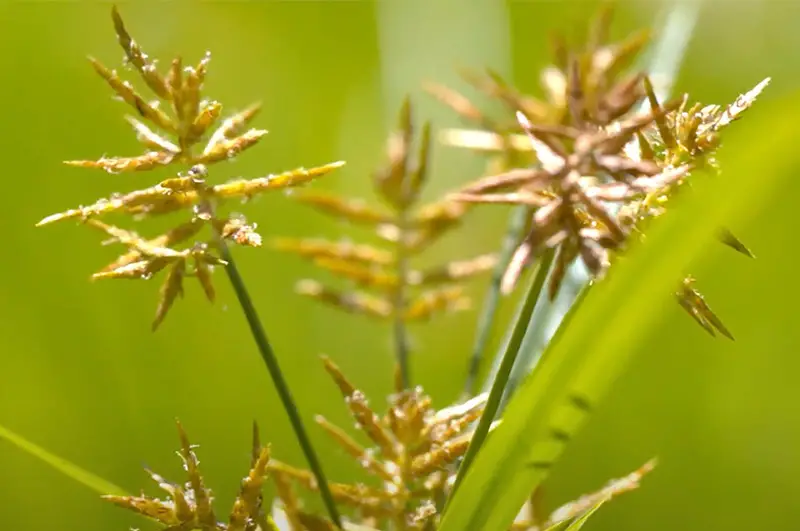
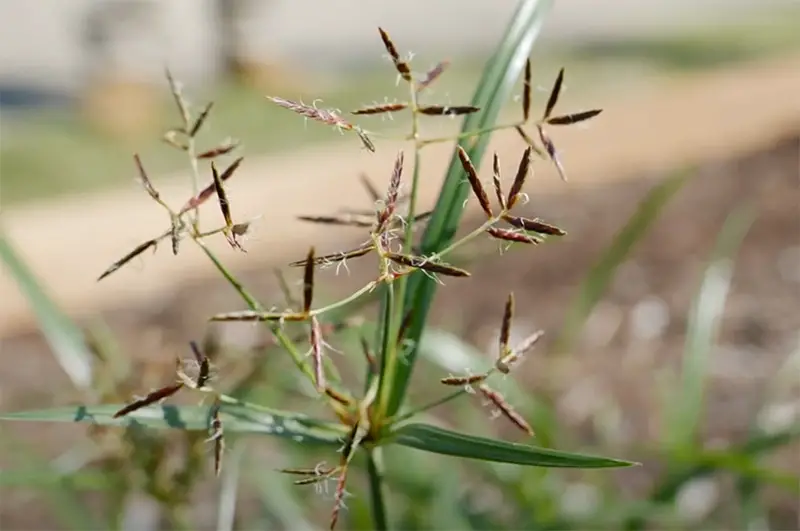
| Yellow Nutsedge | Purple Nutsedge | |
| Leaves | Lighter green leaves with longer leaf tips that taper to a gradual point | Darker green leaves that taper to a sharper point |
| Flowers | Yellow | Purple |
| Seed Heads | Yellowish-brown | Reddish-brown |
| Height | 12 to 16 inches tall | <6 inches tall |
Nutsedge Control and Prevention
The best way to control and prevent nutsedge in your lawn is to remove the ideal conditions it needs to grow while improving the health of your wanted grass or plants. You can achieve this by improving the drainage of your soil and following a proper watering schedule, and maintaining your lawn or garden so it’s full of thick, healthy grass or plants.
Keep Nutsedge Tubers Out of Lawn
It only takes one single tuber rooting in your lawn to trigger a full-blown nutsedge infestation. Tubers can be easily introduced into your yard through dirt, mulch, floodwaters, and compost. Also, walking over nutsedge may cause you to inadvertently carry tubers back to your yard on your shoes and clothes.
You can prevent nutsedge in your lawn by keeping an eye out for it in your nearby environment, including on your neighbors’ lawns. Be mindful of visiting other people’s lawns or farms, and check that they don’t have a nutsedge infestation of their own before you visit. As good practice, wash any tools thoroughly after lending them to someone else before using them on your own lawn.
Test Soil for Nutsedge Tubers
Another way to prevent nutsedge from taking root in your soil is to test it for tubers and nutlets. This is particularly important if you’re putting down new soil to ensure you aren’t introducing the weed through an infected batch.
Take a sample of your current soil or the new soil you’re putting down. Sift it around on a paper towel and look closely at the sample. Referring to pictures of nutsedge, make sure that your soil doesn’t contain any tubers or nutlets.
Apply Appropriate Herbicide Regularly
Incorporating the application of a herbicide into your usual lawn care routine is the best way to prevent the growth of all weeds, including nutsedge.
You have the choice of using either a chemical or organic herbicide. While chemical herbicides work quickly, they can be extremely damaging to the local environment. Organic herbicides are slightly less effective but pose much less of a risk to the nearby plant and wildlife.
When choosing a product, the most important thing is to check the label to ensure that it is designed to kill the weed you’re targeting; in this case, you need a product described as a nutsedge killer. As an extra tip, you should do a spot test of your chosen nutsedge killer product on a small area of your lawn to ensure it won’t destroy the surrounding grass or nearby plants along with the nutsedge weeds.
Improve Drainage of Lawn
Nutsedge takes over in lawns or yards that have poor quality, moist soil. It spreads most voraciously in low-lying areas of your soil or those next to leaky sprinkler heads. Once the nutsedge has established itself, it will be able to tolerate low levels of moisture and will survive throughout the summer months.
Adjust your mowing schedule so that you’re mowing as frequently as possible while also keeping the grass long; this will help to keep the soil dry. Improve your soil’s drainage and reduce compaction by tilling it and aerating it regularly. If your soil has severe drainage issues, it may be necessary to level and regrade your lawn completely.
Water Properly
As we’ve discussed, nutsedge thrives in lawns that have a consistent level of moisture. These conditions are caused by watering daily, doing so in short spurts throughout the day. So, to avoid encouraging the growth of this weed, you should instead water the soil less frequently but for longer periods of time.
If you have an underground irrigation system, water each zone for 1 to 1 ½ hours, twice a week. For hose-end sprinkler systems, water each zone for 4 hours, once a week.
Mow Grass Higher
As is the case with most weeds, nutsedge weed seeds require access to sunlight to germinate in the soil. Keeping your grass longer in height provides the soil surface with shade, blocking the sun’s rays from reaching the ground where weed seeds lie.
Raise the height on your mowing deck to one of the two highest settings. This keeps the grass longer which will help to prevent the germination of new nutsedge plants.
Maintain a Thick Healthy Lawn
Ultimately, the best method of natural nutsedge control is to maintain a lawn full of thick, healthy, well-fertilized grass. This is done by keeping up with a proper fertilization schedule that ideally involves the use of a slow-release organic fertilizer.
Fertilizing properly, in combination with sufficient watering, mowing, and overseeding, will encourage your grass to grow in as thick and healthy as possible. Take note that these activities are all much more effective if carried out after aerating the lawn. This in turn will help to choke out the growth of all weeds on your lawn, including nutsedge.
How to Get Rid of Nutsedge Naturally
The only method available to get rid of nutsedge naturally is to manually remove it by hand.
Note: this method will only work on smaller immature nutsedge infestations, and it’s likely that you will have to repeat it several times before it will completely get rid of the nutsedge from your lawn or garden. Also, this method of nutsedge control is most effective long-term on soil that contains other healthy grass or plants able to outcompete the weed.
1. Wait Until Spring
This method is best carried out in spring when the nutsedge plants are just beginning to sprout.
2. Moisten Soil
If the ground isn’t already moist from rainfall, add some water to moisten it. This will ease the removal process of the nutsedge plants and will help to prevent fragments of the plant’s root system from being left in the soil.
3. Carefully Pull Up Nutsedge Plants
Grasp the nutsedge plant and slowly but firmly pull it from the ground. Make sure to remove the entirety of the plant, along with its whole root system, including the plant’s small nutlets and tubers. If the nutsedge plant shows some resistance and/or your soil is severely compacted, use a pitchfork to first loosen the ground around the weed.
4. Overseed Bare Patches
If working on a lawn, once you have finished pulling, check the area for bare spots of soil. Overseed the bare spots with an appropriate seed for overseeding. Overseeding your weedy lawn is a great method of natural weed control as it will help the turfgrass to outcompete new nutsedge growth; grass does spread to bare spots on its own, but overseeding is necessary at this stage to choke out the nutsedge.
5. Monitor Soil and Repeat Process
Monitor the affected soil and keep an eye out for signs that the nutsedge is returning. Repeat the previous steps as many times as it takes to completely get rid of the nutsedge plants. It may take quite a few repeated pullings before this method takes full effect.
How to Kill Nutsedge with Nutsedge Weed Killer
For the majority of infestations, the best method to get rid of nutsedge is to kill it with a specially-designed nutsedge weed killer.
Note: Make sure that you pick the right weed killer for the type of nutsedge on your lawn; products will either be designed solely to kill yellow nutsedge or purple nutsedge, while some are designed to kill both. Also, check that the product you intend to use won’t cause any harm to the surrounding grass or plants in your yard.
1. Determine What Type of Nutsedge You’re Dealing With
Take a closer look at the weed growing on your lawn. First, confirm that it’s definitely nutsedge using the identification tips provided earlier in this article. Next, determine whether you’re dealing with yellow nutsedge or purple nutsedge.
2. Purchase Appropriate Nutsedge Killer
After identifying the exact type of nutsedge you’re dealing with, purchase an appropriate nutsedge weed killer product. There are a number of post-emergent herbicide products available for nutsedge control, so all you need to do is look for one that is specifically labeled as a nutsedge or nutgrass killer.
3. Purchase a Weed Killer Surfactant
Once you have chosen an appropriate nutsedge killer, purchase a weed killer surfactant. While this step isn’t essential, it will greatly enhance the effectiveness of the nutsedge killer. Surfactants help the weed killer to stick to the nutsedge plants’ waxy leaves, assisting the active ingredients to penetrate the weeds’ foliage.
Take note that some nutsedge weed killers have an already-incorporated surfactant, while some explicitly state that they’re not to be used with a surfactant at all. Always check the label of your product for exact guidance on whether you can mix it with a surfactant.
4. Put on Protective Clothing
Before applying the nutsedge killer, put on full protective clothing to protect yourself from the chemicals. Wear long pants and a long-sleeved shirt, rubber gloves, work boots, and goggles.
5. Apply Nutsedge Killer to Affected Area
Add your chosen nutsedge killer to a hand-pump sprayer, following the instructions on the label of your product for the correct water-to-product ratio. If you chose to use a surfactant, mix it into the sprayer with your chosen nutsedge killer. Make sure to refer to the label of your chosen nutsedge killer for exact safety and application instructions. Following the instructions, apply the nutsedge killer to the affected area.
6. Overseed Bare Patches
If working on a lawn, overseed any bare patches leftover once the nutsedge plants have been killed. See our article How Long After Weed Killer Can I Plant Grass Seed for more information on how long to wait between the weed killer application and the planting of the new grass seed.
7. Monitor Soil and Repeat Process As Necessary
Monitor the soil for regrowth of the nutsedge and reapply the nutsedge killer as necessary. As a general rule, wait at least four weeks after the initial application before reapplying the herbicide. The label of your chosen nutsedge killer will provide exact instructions for how long to wait between applications.

